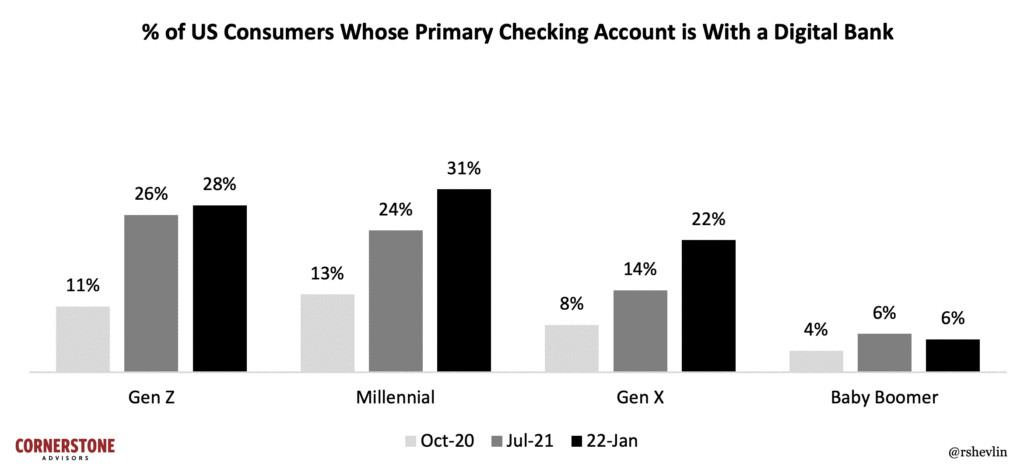The growth of neobanks is inevitable, especially amid the digital revolution and evolving customer preferences. Younger, tech-savvy generations demand convenience, constant access, and personalized services.
The pandemic significantly expedited this shift, necessitating the rapid adoption of digital and remote banking. Neobanks capitalize on this by leveraging cutting-edge technologies like AI and blockchain, offering user-friendly experiences and cost-effective services. They stand out for their robust security measures, earning customer trust.
Additionally, their global spread caters to diverse niches and demographics, often encouraged by supportive governmental and regulatory environments. Despite facing challenges such as adapting to complex regulatory landscapes and building long-term customer loyalty, neobanks are redefining the banking landscape.
They implement innovative business models by tapping into underbanked segments. With their growth driven by venture funding and changing demographics, neobanks represent a dynamic and significant shift in the financial sector. Neobanks are poised to expand financial inclusion and transform traditional banking paradigms.

Understanding the Neobank Phenomenon
Neobanks are digital-only banks without physical branches, leveraging cutting-edge technology to offer banking services. These entities operate primarily via mobile applications and websites, providing a seamless and intuitive user experience. As of late, the global neobanking market is experiencing exponential growth.
The market had a $69 billion valuation in 2022 and is projected to reach $3.3 trillion by 2032. The backbone of neobanks is advanced technology, including artificial intelligence (AI), blockchain, big data, and machine learning (ML). These technologies enable neobanks to offer personalized services, enhanced security, and swift transaction capabilities.
AI and machine learning algorithms allow for sophisticated credit scoring systems and personalized financial advice, setting these banks apart from traditional institutions.
Neobanks have significantly impacted the financial ecosystem, particularly when it comes to customer expectations and service delivery. Millennials now use digital banking platforms, with a significant portion favoring neobanks due to their convenience, user-friendly interfaces, and innovative features.

Image Courtesy: Forbes
How Traditional Banks Are Responding to the Challenge
Here’s how traditional banks are responding to this banking revolution.
Digital transformation initiatives
Faced with the rising popularity of neobanks, traditional banks are aggressively pursuing digital transformation. This includes upgrading legacy systems, investing in digital banking platforms, and adopting technologies like AI and blockchain. For example, JPMorgan Chase & Co. announced a $12 billion annual technology budget to enhance its digital banking services.
Strategic partnerships and acquisitions
Strategic partnerships and acquisitions by traditional banks in the fintech and neobanking sectors represent a pivotal shift in the financial services landscape. Legacy systems and regulatory complexities often constrain traditional banking institutions.
As such, they find it increasingly challenging to innovate at the pace demanded by today’s digital-savvy consumers. They can leapfrog some of these barriers by forming strategic partnerships or outright acquiring fintech and neobanking startups.
These startups often come with cutting-edge technologies and more user-friendly digital interfaces, which are critical in today’s market. These partnerships or acquisitions allow traditional banks to diversify their service offerings. It enables them to tap into the innovative business models and niche markets these startups often occupy.
From a strategic standpoint, these collaborations are mutually beneficial. For traditional banks, they provide a fast track to digital transformation. With it, they can remain competitive in an industry increasingly dominated by technology. They gain access to novel financial products, expertise in digital customer experience, and, sometimes, a younger customer base.
On the other hand, fintech and neobanking startups often struggle with scaling up, regulatory hurdles, and establishing trust. By partnering with or being acquired by a well-established bank, they can leverage its regulatory expertise, brand recognition, and extensive customer networks.
This symbiotic relationship accelerates innovation in the financial sector, driving incumbents and new entrants toward more customer-centric and efficient banking models.
Focusing on customer experience
Enhancing customer experience is another area where traditional banks are concentrating their efforts. This involves digitizing existing services and reimagining customer interactions to be more personalized, efficient, and engaging. Banks leverage data analytics to understand customer needs better and tailor their services accordingly.
Traditional financial institutions are placing a renewed emphasis on elevating the customer experience. This shift goes beyond merely digitizing existing services. It also involves rethinking how customers interact with their bank.
By harnessing the power of data analytics, banks gain deeper insights into individual customer preferences and behaviors. This data-driven approach enables them to offer more personalized, efficient, and engaging services.
In doing so, traditional banks are not just responding to the competitive challenge posed by neobanks. They are also shaping a future where customer satisfaction is at the heart of banking innovation.
The Future Landscape of Banking
The future of banking is poised to witness the continued rise of neobanks. The future will likely see a blend of competition and collaboration between traditional banks and neobanks. While they compete for market share, there are opportunities for mutually beneficial relationships.
Traditional banks can offer regulatory expertise and a broad customer base, while neobanks bring innovation and agility. These advancements will make banking services, like savings accounts and home mortgage loans, more accessible.
The regulatory landscape will be crucial in shaping the future of neobanks. As these entities gain traction, regulators worldwide are working to establish frameworks that ensure consumer protection, financial stability, and fair competition. The evolving regulatory environment will determine the long-term success and integration of neobanks in the global banking ecosystem.
Embrace the Future of Digital Finance
The rise of neobanks represents a pivotal moment in the banking industry, signifying a shift toward more agile, technology-driven financial services. Their impact extends beyond just offering digital convenience. They are redefining customer expectations, driving innovation, and compelling traditional banks to adapt swiftly.
As the landscape evolves, traditional banks and neobanks will likely shape the future of banking. Banks with agile systems can gain most of the market share in this dynamic environment.










